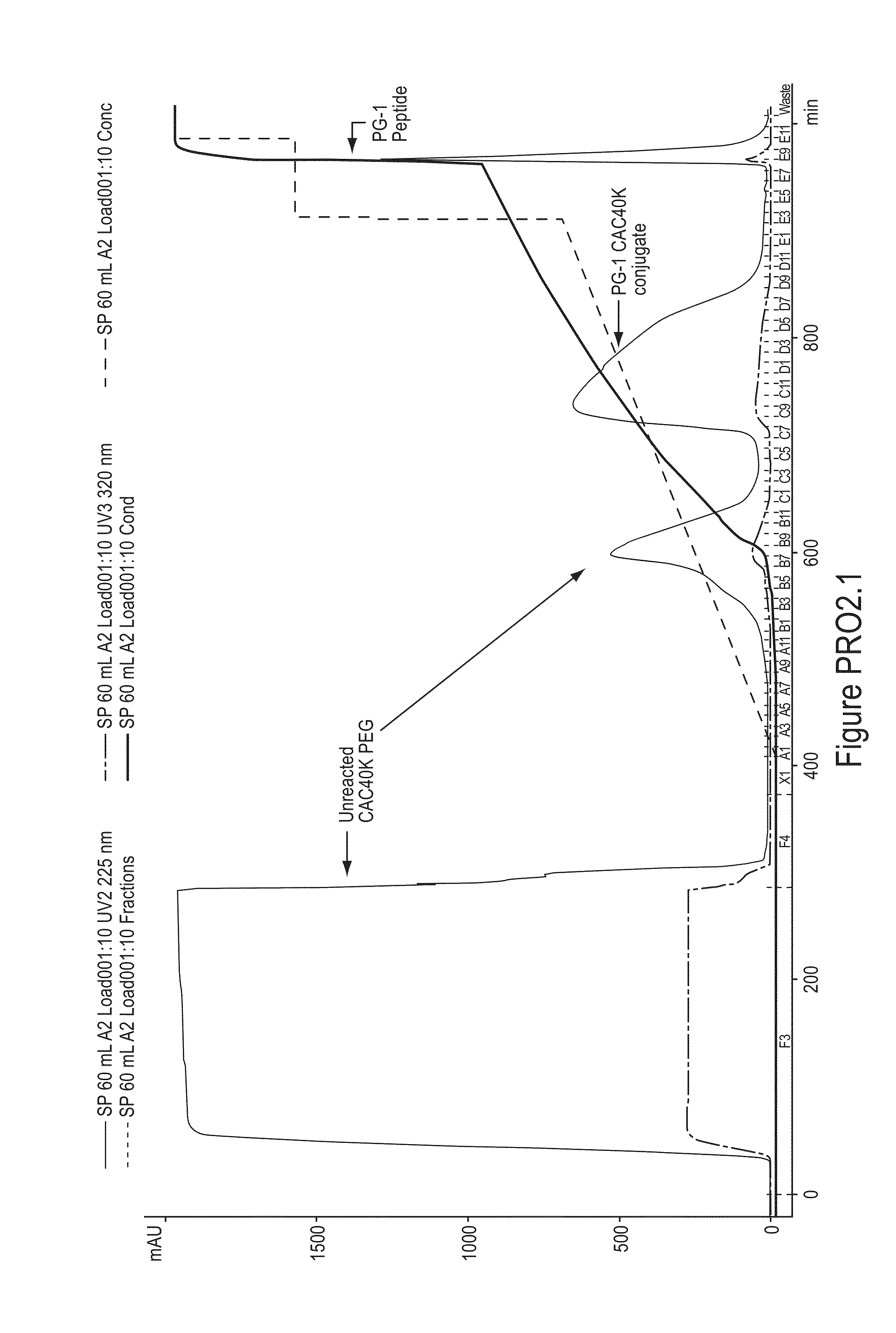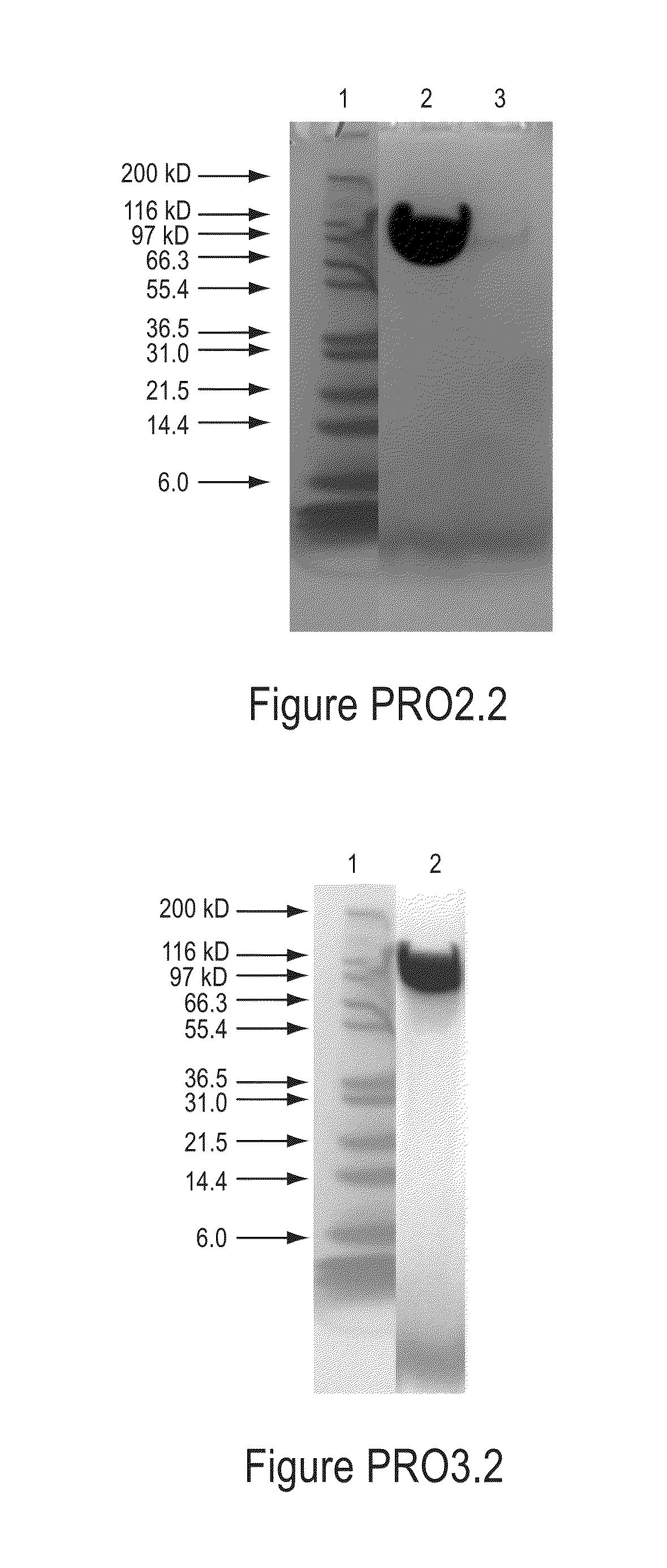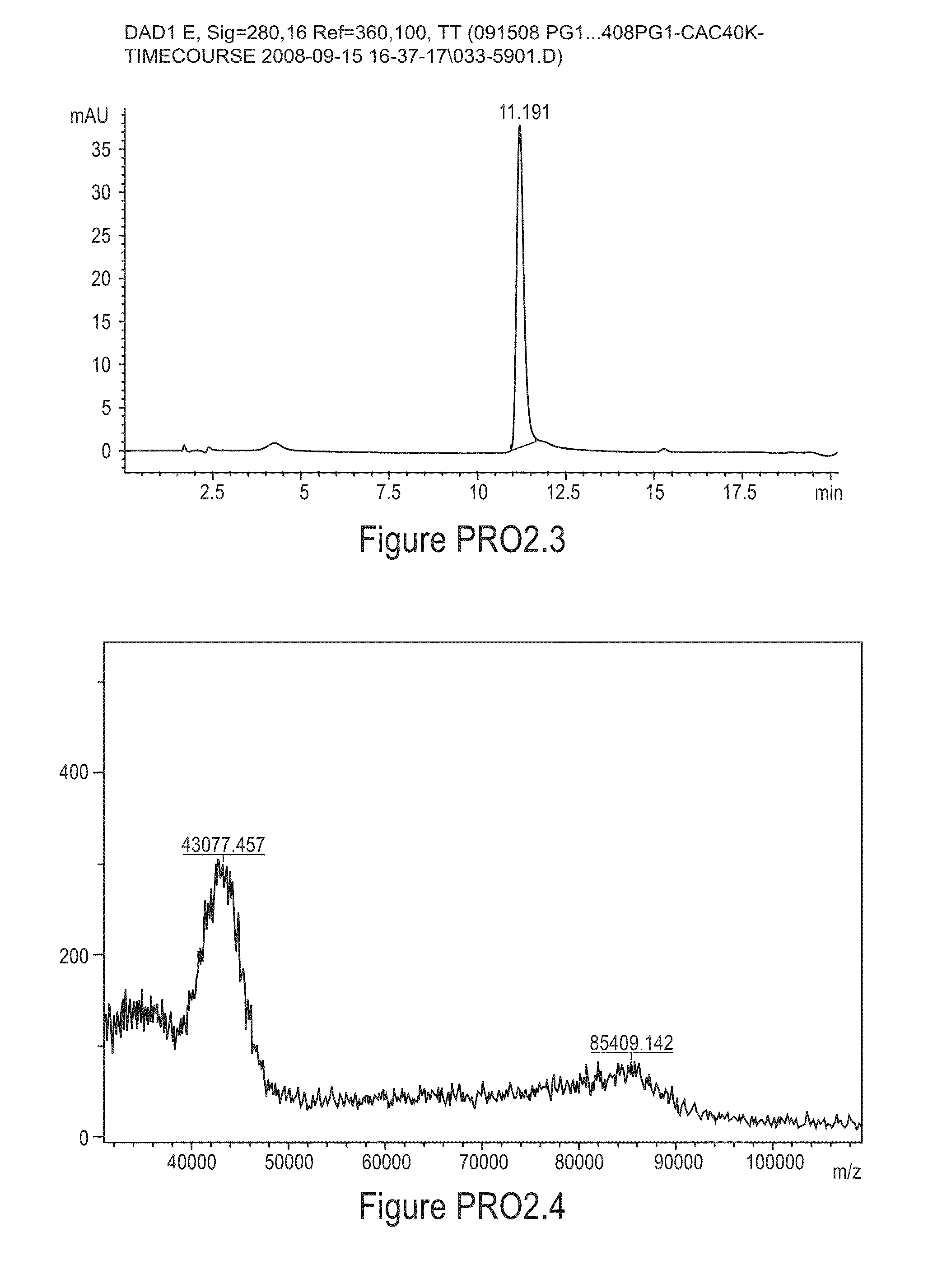Polymer conjugates of protegrin peptides
a technology of protegrin peptides and conjugates, which is applied in the field of conjugates, can solve the problems of short in vivo half life of peptides, cell death, and general impracticality
- Summary
- Abstract
- Description
- Claims
- Application Information
AI Technical Summary
Benefits of technology
Problems solved by technology
Method used
Image
Examples
example pro1
Protegrin-mPEG Conjugates
[0298]a) mPEG-Nter-Protegrin via mPEG-SPC
[0299]Protegrin is prepared and purified according to standard automated peptide synthesis or recombinant techniques known to those skilled in the art. An illustrative polymeric reagent, mPEG-SPC reagent,
is covalently attached to the N-terminus of protegrin, to provide a 1N-conjugate form of the peptide. mPEG-SPC 20 kDa, stored at −20° C. under argon, is warmed to ambient temperature. The reaction is performed at room temperature. An X-fold molar excess of mPEG-SPC 20 kDa reagent is used based upon absolute peptide content. The mPEG-SPC reagent is weighed into a glass vial containing a magnetic stirrer bar. A solution of Protegrin prepared in phosphate buffered saline, PBS, pH 7.4 is added and the mixture is stirred using a magnetic stirrer until the mPEG-SPC is fully dissolved. The stirring speed is reduced and the reaction is allowed to proceed to formation of conjugate product. The reacti...
example pro2
PEGylation of Protegrin-1 (PG-1) with [mPEG2-CAC-FMOC-NHS-40K]
[0318]
[0319]Stock solutions of 5.0 mg / mL PG-1 and 200 mG / mL mPEG2-CAC-FMOC-NHS-40K were prepared in 2 mM HCl. To initiate a reaction, the two stock solutions and a 0.5 M MES, pH 6.0, stock solution were brought to 25° C. and the three stock solutions were mixed (PEG reagent added last) to give final concentrations of 1.0 mg / mLPG-1, 50 mM MES and a 5-fold molar excess of mPEG2-CAC-FMOC-NHS-40K over PG-1. After 3.5 hours at 25° C. the reaction was quenched with 100 mM glycine in 100 mM HCl (10 mM final glycine concentration) for 1 hour. The reaction mixture was then diluted with deionized sterile water until the conductivity was below 1.0 mS / cm and the pH was adjusted to 6.0 with 1 M Na2CO3 / NaHCO3, pH 10.0.
[0320]The mono-PEGylated conjugate was purified from the reaction mixture by cation exchange chromatography using a column packed with SPHP media (GE Healthcare) on an AKTA Explorer 100 system (GE Healthcare). Buffer A wa...
example pro3
PEGylation of Protegrin-1 (PG-1) with N-m-PEG-Benzamide-p-Succinimidyl Carbonate (SBC)-30K
[0329]
[0330]A stock solution of 1.2 mg / mL PG-1 was prepared in 2 mM HCl. To initiate a reaction, the PG-1 stock solution was brought to 25° C., a 15-fold molar excess of SBC-30K lyophilized powder was with stirring followed immediately with the addition of 1 M MES, pH 6, to give final concentrations of 1.0 mG / mL PG-1 (0.46 mM) and 50 mM MES. The reaction was allowed to proceed for 20 minutes at 25° C. After 20 min, the reaction was quenched with 100 mM glycine in 100 mM HCl (10 mM final glycine concentration) for 10 minutes. The reaction mixture was then diluted with deionized sterile water until the conductivity was below 1.0 mS / cm and the pH was adjusted to 4.0 with 1 M sodium acetate, pH 4.5 diluted.
[0331]The mono-PEGylated conjugate was purified from the reaction mixture by cation exchange chromatography using a column packed with SPHP media (GE Healthcare) on an AKTA Explorer 100 system (G...
PUM
| Property | Measurement | Unit |
|---|---|---|
| weight average molecular weight | aaaaa | aaaaa |
| weight-average molecular weight | aaaaa | aaaaa |
| weight-average molecular weight | aaaaa | aaaaa |
Abstract
Description
Claims
Application Information
 Login to View More
Login to View More - R&D
- Intellectual Property
- Life Sciences
- Materials
- Tech Scout
- Unparalleled Data Quality
- Higher Quality Content
- 60% Fewer Hallucinations
Browse by: Latest US Patents, China's latest patents, Technical Efficacy Thesaurus, Application Domain, Technology Topic, Popular Technical Reports.
© 2025 PatSnap. All rights reserved.Legal|Privacy policy|Modern Slavery Act Transparency Statement|Sitemap|About US| Contact US: help@patsnap.com



